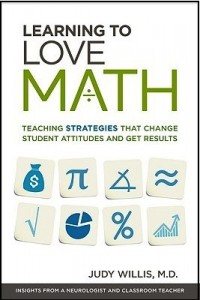Exciting Students about Math
Learning to Love Math: Teaching Strategies That Change Student Attitudes and Get Results
by Judy Willis, MD
(ASCD, 2010 – Learn more)
I’ve always believed being good in math is more about attitude than aptitude, so the idea of this book appealed me. I hoped to gain ideas that would help me help my students learn to love math as much as I do. I was not disappointed.
From the last paragraph in the introduction: You and your students will even find an answer to the common question, “Why do we have to learn this?” The answer: “Because it makes our brains grow and we become smarter!” — to the Appendix B: Brain Owner’s Manual — this book is chock full of useful, practical ideas for teachers to apply in their classrooms.
Many of Judy Willis’ ideas are familiar: connect math to real world application, encourage students to set their own learning goals, and find unique ways to motivate your students. For these been there/done that ideas, Willis offers her own takes on how to achieve these often seemingly unattainable goals. I love her idea of color coding ideas with green, yellow and red to show increased importance. I’ve always found giving students color to highlight notes to be valuable, but this color scheme would be a fantastic way to help students prioritize notes in any subject.

Many of her ideas reinforce what effective teachers already do – calling on multiple students before acknowledging whether an answer is correct, finding ways to make even a wrong answer useful in some way, and avoiding boredom by differentiating instruction to meet the needs of a variety of learners and abilities. But again, with each of these ideas, Willis manages to infuse her suggestions with unique twists to encourage the reader to reach beyond their own comfort zone to apply these in the classroom.
Map Readers and Explorers
Willis suggests students are grouped into two types of learners: Map Readers and Explorers. I love this notion! How less intimidating than ‘visual’ or ‘auditory’ or ‘kinesthetic’ learners – categories I never seemed to manage to pigeonhole even myself into appropriately. But being a map reader — someone who likes to pour over instructions, be directed specifically, and is logical and orderly — makes sense to me. As does the other extreme — being an explorer who uses the imagination, does things first then reads instructions later, and responds well to choices. I can see the differences in those personality types and how students who fit those categories would learn differently and need different exposure to new information.
I also love that Willis advocates the use of small wipe boards! I’ve always loved using erasable slates with students, for the same reasons she suggests: all students are engaged with their own “device,” and the small whiteboards promote quick and easy feedback for all students.
Overall, I was impressed with this book. It gave me much to think about. I saw things I do well, and other things where I thought, “DUH! I should have drawn that same conclusion.” There were other good ideas I had never considered.
Willis hits a home run when it comes to helping teachers get students excited about math. And maybe even learning to love it.
Cossondra George is a middle/high school special education and math teacher. She enjoys writing about her teaching experiences and has had several articles featured in Education Week’s Teacher including Making Math Meaningful for All. George engages students using technology and has been active in helping other teachers integrate technology into their classrooms. She also blogs about her teaching days at Middle School, Day by Day from a Teacher’s Point of View.

































I like how you said “connect math to real world application, encourage students to set their own learning goals, and find unique ways to motivate your students.” I definitely agree. A lot of students get discouraged about math because they don’t understand the worth behind the subject. Explaining math to students in less complex way helps to diminish this issue. I’m going to go ahead and check out this book, thanks! I think you should definitely look into checking out the videos on reelmath. On the website are student-made videos that explain math in real world situations. Really interesting and helpful, I’d say. (http://reelmath.org/videos)